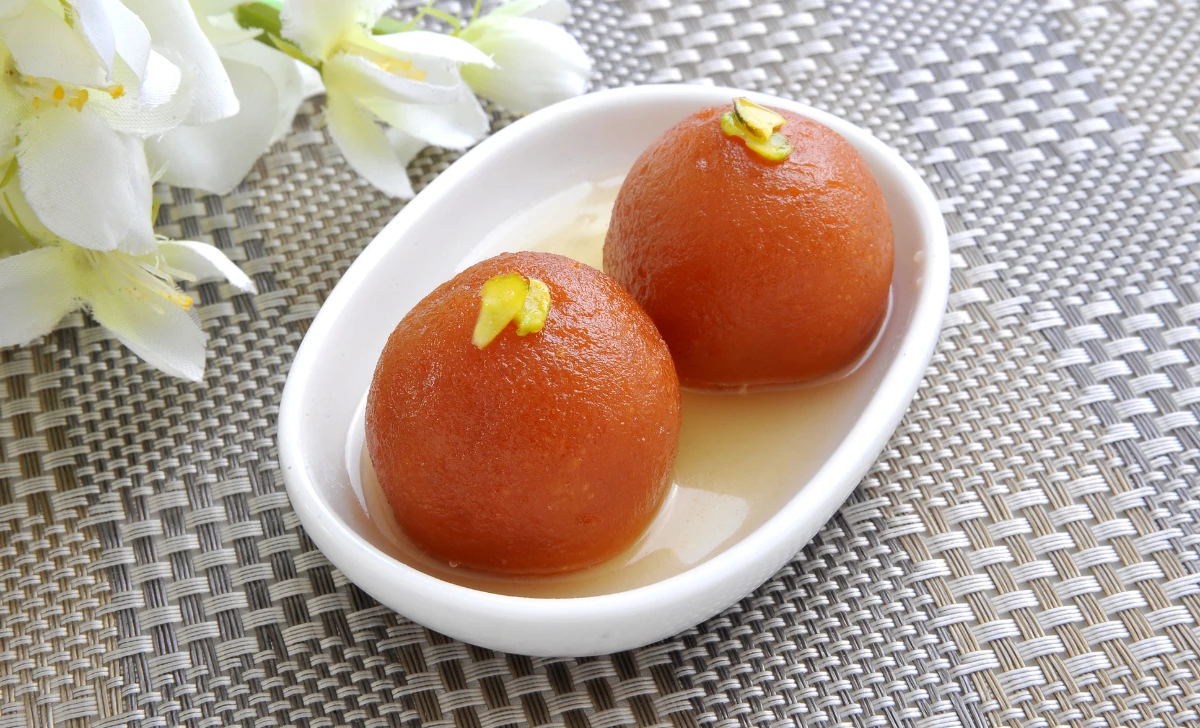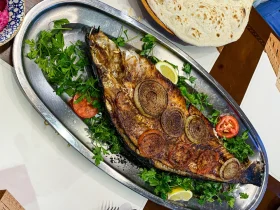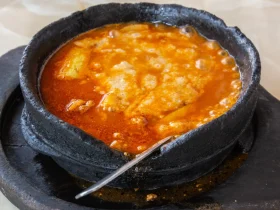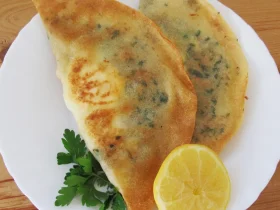Gulab Jamun is a popular Indian dessert that has a long-standing history in the culinary traditions of the Indian subcontinent. The name “Gulab Jamun” is derived from two words: “Gulab,” which means rose, and “Jamun,” referring to a berry-like fruit with a similar size and shape to the sweet. Gulab Jamun is often served during festivals, celebrations, and special occasions, making it an integral part of Indian culture.
[ez-toc]
History
The history of Gulab Jamun dates back centuries, showcasing its rich cultural heritage and significance in the Indian subcontinent. The origins of Gulab Jamun can be traced to medieval India, during the Mughal era. The Mughal emperors, known for their love for gastronomy and lavish feasts, greatly influenced the culinary landscape of the region.
Gulab Jamun evolved from a Persian sweet known as “luqmat al-qadi,” which means “judge’s morsel” in Arabic. The Persian version consisted of deep-fried dough balls soaked in honey syrup. When the Mughals arrived in India in the 16th century, they brought their refined tastes and culinary traditions, including the precursor to Gulab Jamun.
Over time, the recipe for Gulab Jamun underwent modifications, adapting to local ingredients and flavors. The use of milk solids, such as khoya (reduced milk) or milk powder, became a distinctive feature of the Indian version. This alteration gave Gulab Jamun its unique texture and creamy richness.
The name “Gulab Jamun” reflects the infusion of Indian flavors and culture into the sweet. “Gulab” translates to “rose water” in Hindi, referring to the fragrant syrup that Gulab Jamun is soaked in. “Jamun” is derived from the Indian fruit called “Jamun,” which is dark purple and resembles the shape of the sweet. The combination of these elements resulted in the name that we know today.
Gulab Jamun quickly gained popularity among the nobility and aristocracy, becoming a signature dessert in the royal kitchens. It was served during grand feasts, celebrations, and important occasions. As the Mughal Empire declined, Gulab Jamun spread beyond the royal courts and became a part of the broader Indian culinary tradition.
Today, Gulab Jamun is an integral part of Indian cuisine and is cherished across the country. It has transcended regional boundaries and is enjoyed by people of diverse backgrounds. The recipe has been passed down through generations, with each family adding its unique touch and variations.
The cultural significance of Gulab Jamun extends beyond its taste and aroma. It represents warmth, hospitality, and the spirit of togetherness. It is often prepared during festivals like Diwali, Eid, and weddings, symbolizing joy, love, and abundance. Gulab Jamun has become a timeless dessert that continues to bring people together, celebrating the shared heritage and culinary traditions of India.
Time
| Step | Time (approx.) |
|---|---|
| Making the Gulab Jamun Dough | 20 minutes |
| Shaping and Frying the Gulab Jamun | 30 minutes |
| Making the Sugar Syrup | 10 minutes |
| Soaking the Gulab Jamun in Syrup | 30 minutes |
| Total | 1 hour 30 minutes |
Please note that the preparation time may vary depending on individual cooking skills and equipment used. It’s always a good idea to allocate some extra time for unexpected delays or interruptions.
Ingredients
| Ingredients | Quantity |
|---|---|
| Milk powder | 1/2 cup |
| All-purpose flour | 1/4 cup |
| Baking soda | 1/8 teaspoon |
| Ghee (clarified butter) | 1 tablespoon |
| Cardamom powder | A pinch |
| Saffron strands | A pinch |
| Sugar | 1/2 cup |
| Water | 1/2 cup |
| Rose water | 1/2 teaspoon |
| Vegetable oil (for frying) | Sufficient for deep frying |
Note: The above quantities are based on a serving size for 2 people. Adjust the quantities accordingly if you need to serve more or fewer people.
Directions
Step 1: Making the Gulab Jamun Dough
- In a mixing bowl, combine the milk powder, all-purpose flour, and baking soda.
- Add the ghee to the dry ingredients.
- Mix the ingredients together until they form a soft dough. Avoid overmixing, as it can make the Gulab Jamun dense.
- Cover the dough and let it rest for 15-20 minutes. This will allow the dough to become more pliable.
Step 2: Shaping and Frying the Gulab Jamun
- After the resting period, take a small portion of the dough and roll it between your palms to make a smooth ball. Ensure there are no cracks on the surface.
- Repeat the process to shape all the Gulab Jamun balls.
- Heat vegetable oil in a deep pan or kadai over medium heat.
- Gently slide the Gulab Jamun balls into the hot oil. Fry them on low to medium heat, stirring occasionally, until they turn golden brown.
- Remove the fried Gulab Jamun from the oil using a slotted spoon and place them on a paper towel to absorb excess oil.
Step 3: Making the Sugar Syrup
- In a separate saucepan, combine the sugar and water.
- Place the saucepan over medium heat and stir the mixture until the sugar dissolves completely.
- Add a pinch of cardamom powder and a few strands of saffron to the syrup for added flavor and aroma.
- Simmer the syrup for 5-7 minutes until it achieves a slightly sticky consistency.
Step 4: Soaking the Gulab Jamun in Syrup
- Once the sugar syrup is ready, remove it from the heat and let it cool for a few minutes.
- Add rose water to the syrup and stir well.
- Gently place the fried Gulab Jamun into the warm syrup, ensuring they are completely submerged.
- Allow the Gulab Jamun to soak in the syrup for at least 30 minutes. During this time, they will absorb the syrup and become soft and moist.
Serve the Gulab Jamun warm or at room temperature, garnished with finely chopped pistachios, almonds, or silver leaf (varak). Enjoy this delectable Indian sweet and savor its rich flavors!
Equipment Required
Nutrition Information
| Nutrition Information | Amount per Serving |
|---|---|
| Serving Size | 2 Gulab Jamun |
| Calories | 250 |
| Total Fat | 10g |
| Saturated Fat | 5g |
| Cholesterol | 25mg |
| Sodium | 100mg |
| Total Carbohydrate | 35g |
| Dietary Fiber | 1g |
| Sugars | 25g |
| Protein | 4g |
Note: The nutrition information provided is an estimate and may vary based on specific ingredients used and portion sizes.
Tips
- Maintain the right consistency: Ensure that the Gulab Jamun dough is soft and pliable. If it feels dry, add a few drops of water or milk to achieve the desired consistency. The dough should not be too sticky either, as it can result in dense Gulab Jamun.
- Rest the dough: Allowing the dough to rest for 15-20 minutes after preparation makes it more manageable and enhances its texture. The resting time helps the dough to hydrate and become easier to work with while shaping the Gulab Jamun.
- Moderate oil temperature: Maintain a medium heat while frying the Gulab Jamun. If the oil is too hot, the outer layer may darken quickly while the inside remains uncooked. Frying on low to medium heat ensures that the Gulab Jamun cook evenly and attain a golden brown color.
- Avoid overcrowding: Fry the Gulab Jamun in batches, making sure not to overcrowd the pan. Overcrowding can lead to uneven cooking and result in greasy Gulab Jamun. Give them enough space to expand while frying.
- Sugar syrup consistency: The sugar syrup should have a slightly sticky consistency. If it becomes too thick, the Gulab Jamun may not soak up the syrup properly. If it is too thin, the Gulab Jamun can become overly saturated and lose their texture.
- Warm syrup for soaking: Ensure that the sugar syrup is warm when you add the fried Gulab Jamun. Warm syrup allows the Gulab Jamun to soak properly and absorb the flavors, making them soft and moist.
Pros & Cons
| Pros | Cons |
|---|---|
| ✔️ Delicious and indulgent | ❌ High in calories and fat |
| ✔️ Easy to make | ❌ Requires deep-frying |
| ✔️ Loved by people of all ages | ❌ Not suitable for those with dietary restrictions or allergies |
| ✔️ Perfect for festive occasions and celebrations | ❌ Time-consuming preparation process |
| ✔️ Can be customized with variations and garnishes | ❌ Can be overly sweet for some individuals |
Conclusion
In conclusion, Gulab Jamun is a truly delightful Indian sweet that brings joy and sweetness to any occasion. This recipe allows you to create these soft, spongy dumplings soaked in a fragrant syrup right in your own kitchen. With its delicious flavors and cultural significance, Gulab Jamun holds a special place in Indian cuisine and celebrations.
The process of making Gulab Jamun is approachable, even for beginners, and the ingredients are easily accessible. By following the step-by-step instructions, you can create Gulab Jamun that rival those from your favorite sweet shop. The soft dough, golden brown exterior, and aromatic syrup combine to create a truly indulgent treat.
While Gulab Jamun is undeniably rich and calorie-dense, it is a dessert meant to be enjoyed in moderation and savored on special occasions. Its enticing flavors and presentation make it a centerpiece of festivities and a symbol of love and togetherness.
So why not give it a try? Gather the ingredients, follow the recipe, and embark on a journey to create this mouthwatering Indian sweet. The process of making Gulab Jamun is not only about the end result but also about the joy of cooking and sharing a cultural experience with loved ones. So go ahead, roll up your sleeves, and savor the sweetness of Gulab Jamun.
Facts
- Fact: A Sweet Fit for Royalty! 👑
- Gulab Jamun was a favorite dessert of the Mughal emperors and was often served in their grand feasts. It was considered a delicacy fit for royalty, adding a touch of luxury to the dining experience.
- Fact: A Sibling Duo of Sweetness! 🍡🍯
- Gulab Jamun has a close relative called “Rasgulla” in Indian cuisine. While Gulab Jamun is made from a dough of milk solids, Rasgulla is made from cottage cheese (paneer). Together, they form a dynamic duo of delectable sweets loved by many.
- Fact: A World Record Worth Celebrating! 🏆
- In 2012, India set a Guinness World Record for the largest serving of Gulab Jamun. A whopping 5,000 kilograms (11,023 pounds) of Gulab Jamun was prepared and served, delighting thousands of people with its sweet abundance.
- Fact: Gulab Jamun, The Global Sweet Sensation! 🌍
- Gulab Jamun has gained popularity beyond India and is beloved worldwide. It has become a part of international cuisine, with variations and adaptations in countries like Pakistan, Bangladesh, Nepal, Sri Lanka, and even the Caribbean.
- Fact: A Sweet Journey Through Time! ⏳
- Gulab Jamun has a history that spans centuries. From its Persian roots as “luqmat al-qadi” to its evolution in Mughal kitchens and its prominence in Indian culture, this delightful dessert has traveled through time, carrying the essence of sweetness with it.
FAQ’s
Can I use wheat flour instead of all-purpose flour to make Gulab Jamun?
It’s best to use all-purpose flour for Gulab Jamun, as it provides the desired texture. Wheat flour may result in denser Gulab Jamun.
Can I use store-bought Gulab Jamun mix instead of making the dough from scratch?
Yes, you can use store-bought Gulab Jamun mix as a time-saving alternative. Follow the instructions on the package for the best results.
Can I make Gulab Jamun without frying them?
Frying is a crucial step in making Gulab Jamun, as it gives them their characteristic texture and golden color. Baking or steaming may alter the taste and texture significantly.
How long does Gulab Jamun stay fresh?
Gulab Jamun can be stored in an airtight container at room temperature for up to 2 days. However, they are best enjoyed within the first 24 hours for optimal taste and texture.
Can I reheat Gulab Jamun?
Yes, you can reheat Gulab Jamun by placing them in a microwave-safe dish and heating them in short intervals until warm. However, they are usually enjoyed at room temperature or slightly warm.
Can I freeze Gulab Jamun?
Yes, you can freeze Gulab Jamun. Place them in an airtight container or freezer bag and store them for up to 1 month. Thaw them in the refrigerator overnight before reheating or serving.
Can I reduce the sugar in the syrup for a less sweet version?
The sugar syrup is an integral part of Gulab Jamun and contributes to its flavor and texture. While you can reduce the amount of sugar slightly, keep in mind that it may affect the overall taste and authenticity of the dish.
Can I use rose essence instead of rose water in the syrup?
Yes, you can use rose essence as a substitute for rose water. However, use it sparingly, as it is more concentrated in flavor. Adjust the amount according to your preference.
Can I make Gulab Jamun without using ghee (clarified butter)?
Ghee adds richness and flavor to Gulab Jamun. While you can substitute it with melted butter, the taste and texture may differ slightly.
Can I make Gulab Jamun gluten-free?
It can be challenging to make Gulab Jamun completely gluten-free due to the nature of the recipe. Gluten-free alternatives may result in different texture and taste. It’s best to look for specific gluten-free Gulab Jamun recipes using suitable substitutes.












Leave a Review